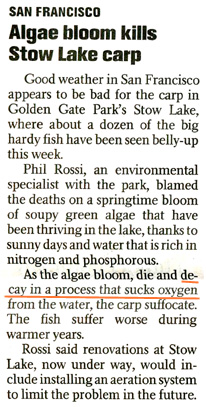| Sewage, or wastewater, includes all the water
from a household that is used to washing and toilet wastes, Rainwater
flowing into street drains and industrial wastes does not usually
enter the sewage system. Sewage is mostly water and contains little
particulate matter, perhaps 0.03%. but contains up to 350 ppm
of biodegradation organic matter called biochemical oxygen demand
(BOD),
Eutrophication
Eutrophication is caused by an overabundance of nutrients
in a body of water. Additional nutrients can cause dense growths
of algae called algal blooms. Once eutrophication
results in blooms of algae or cyanobacteria, the eventual effect
is the same as the addition of biodegradable organism matter.
In the short run, these algae and cyanobacteria produce oxygen.
However, they eventually die and are degraded by bacteria. During
the degradation process, the oxygen in the water is used up, which
may kill fish and other animals. Undegraded remnants of organic
matter settles to the bottom and hasten the filling of a lake.
Biochemical Oxygen Demand
An important concept in sewage treatment, biochemical oxygen
demand (BOD) is a measure of the biologically degradable organic
matter in water. BOD is determined by the amount of oxygen required
by bacteria to metabolize the organic matter. The more oxygen
that is used up as bacteria degrade the organic matter, the greater
the BOD, which is usually expressed in milligrams of oxygen per
liter of water, The amount of oxygen that normally can be dissolved
in water is only about 10 ml/l; typically BOD values may be twenty
times this amount. If this wastewater enters a lake, bacteria
in the lake begin to consume the organic matter responsible for
the high BOD, rapidly depleting the oxygen in the lake water.
| From the S.F.
Chronicle |
 |
|

In this study, you can specify
the following characteristics:
A. The kind of body of water:
1. Large pond
2. Large lake
3. Slow-moving river
4. Fast-moving river
B. The water temperature in degrees Celsius
C. The rate of dumping of waste in parts per millons (ppm)/day.
D. The type of {sewage} treatment of the waste
1. None
2. Primary
3. Secondary
4. Tertiary
|
LINK TO PROGRAM
| Procedure
Run the program and answer the following questions/
For Question 1, run the experiment on each body of water
keeping all other variables (type of treatment, temperature,
and dumping rate) constant: Record your results in Table
2.
For Question 2, run the experiment using different types
of treatment keeping the other variables (body of water,
temperature, and dumping rate) constant. Record your results
in Table 2.
For Question 3, keep the body of water constant and change
one of the other variables.
Questions
1. Which type of waterway is harmed least
by receiving sewage? How can you tell?
2. Which type of sewage was least harmful?
How can you tell?
3. Design your own experiment using POLUT.
What variable did you consider (e.g., temperature, dumping
rate, type of treatment)? Which condition in Table 2 is
your control? What is your conclusion? (Attach
the graph from POLUT and show where it
substantiates your conclusions.) |
|

